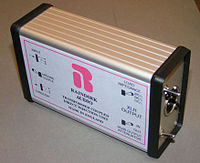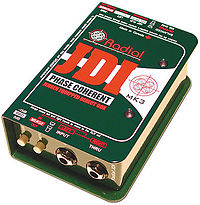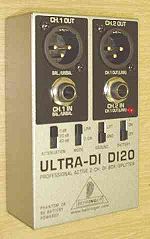- DI unit
-
A DI unit, DI box, Direct Box, or simply DI (variously claimed to stand for direct input, direct injection or direct interface), is a device typically used in recording studios to connect a high-impedance, line level, unbalanced output signal to a low-impedance microphone level balanced input, usually via XLR connector. DIs are frequently used to connect an electric guitar or electric bass to a mixing console's microphone input. The DI performs level matching, balancing, and either active buffering or passive impedance matching/impedance bridging to minimise noise, distortion, and ground loops.
DI (pronounced dee EYE) boxes are extensively used with professional and semi-professional PA systems and in sound recording studios.
Contents
Why a DI Is Necessary
The Direct Injection box takes a high impedance, unbalanced signal and converts it to a low impedance, balanced signal.
This allows the signal to be sent over long cable runs with significantly less signal loss (especially in high frequencies) due to the lowering of the impedance, and greater rejection of interference due to the benefit of common mode rejection in a balanced signal. Furthermore, the lower impedance (around 600 ohms is normal) allows an insignificant load to the input of a mixing console or preamp which is also designed to accept input from low impedance microphones.
Passive DI units
A passive DI unit typically consists of an audio transformer used as a balun. The turns ratio is typically chosen to convert a nominal 50 kΩ signal source (such as the magnetic pickup of an electric guitar) to the 100–200 Ω expected by the input of an audio mixer. Typical turns ratios are in the range of 10:1 to 20:1.[1][2]
Less commonly, a passive DI unit may consist of a resistive load, with or without capacitor coupling. Such units are best suited to outputs designed for headphones or loudspeakers.
The cheaper passive DI units are more susceptible to hum,[3][4] and passive units tend to be less versatile than active. However, they require no batteries, are simpler to use, and the better units are extremely reliable when used as designed.
Some models have no settings, while others can have a ground lift switch (to avoid ground loop problems), a pad switch (to accommodate different source levels) and a filter switch for coloring the sound.[5]
Active DI units
An active DI unit contains a preamplifier. Active DI units can therefore provide gain, and are inherently more complex and versatile than passive units.
Active DI units require a power source, which is normally provided by batteries or a standard AC outlet connection, and may contain the option for phantom power use.
Most active DI units provide switches to enhance their versatility. These may include gain or level adjustment, ground lift, power source selection, and mono or stereo mode. Ground lift switches often disconnect phantom power.
A pass-through connector is a second jack, sometimes simply paralleled to the input connector, that delivers the input signal unchanged, to allow the DI unit to be inserted into a signal path without interrupting it. Pass-through is also commonly referred to as a bypass. True-bypass occurs when the signal goes straight from the input jack to the output jack with no circuitry involved and no loading of the source impedance. False bypass (or simply 'bypass') occurs when the signal is routed through the device circuitry with buffering and no other intentional change to the signal. However, due to the nature of electrical designs there is almost always some slight change in the signal. The extent of change and how noticeable it may be can vary from unit to unit.
Typical applications
Direct boxes are typically used in instances of instruments or other devices that only contain an unbalanced 1/4" output which needs to be connected to an XLR input.[6]
Multiple direct box circuits can be mounted inside one housing. These are used for multiple unbalanced outputs, such as for a bank of electronic keyboards.
Acoustic or electric instruments
DIs can be used on instruments with electronic circuitry and pick ups that do not contain an XLR balanced output. An example of this application would be an electric keyboard that needs to be connected to a mixer board, either directly or through an audio snake. Another example would be an acoustic guitar with pickups, an electric guitar or bass guitar that would be mixed through a mixing console into a main or monitor mix.
Instrument amplifiers
Some instrument amplifiers contain built-in DI units, and can be connected to a mixing console directly without needing an external direct box. This would be a typical setup for a person who wanted to run their instrument through a Public Address (PA) system while keeping the unique sound of the amplifier. Some instrument amplifiers have the ability to turn off the amplifier EQ though a pre eq/post eq switch. This can be used if a "clean" direct output from amplifier is desired.
It is common to use both a DI and a microphone on the same source. One method is to connect a guitar amplifier speaker level output to a DI and then run it to one channel of the mixing console, and run a miked guitar speaker signal into another channel of the mixing console. Another method is to connect a DI between the guitar and the amplifier. The DI signal and miked guitar speaker can then be selectively blended, with the DI providing a more immediate, present, bright, un-equalized sound, and the microphone providing a more 'live' sound, with instrument amplifier characteristics and some room ambience.
Vibrational recorder
A high-voltage turntable cartridge can be used with a direct box to directly record the vibrations from the cartridge's needle to a suitable recording device. This is an inexpensive way to create 'field' recordings of vibrations, such as the substrate-borne vibrational communication of insects.[7] This can be accomplished with a cartridge hooked up to a tripod for stability and a DI box for amplification, which can then be hooked up to a recording device or headphones. By setting the needle on leaves or small branches or grass blades, any insect motion or vibrational communication can be heard through the amplified transduced signal (although this may require trying multiple different blades of grass, branches, etc.).
Valve (tube) amplifiers
Valve (tube) amplifiers need to 'see' a loudspeaker connected to their outputs to prevent damage, and should not be used with DI boxes unless a pass-through link to a loudspeaker is in place, or the DI box is designed for use with these amplifiers.
See also
References
- ^ AES E-Library: Interfacing Electronics and Transformers by Finnern, Thomas
- ^ Electronic Musician, Nov 1, 2001. Scott Wilkinson. Going Direct
- ^ ProSoundWeb Live Audio Board. Cheepie DI's response by Andy Peters
- ^ ProSoundWeb Live Audio Board. Behringer Ultra DI-120 response by Andy Peters
- ^ Whirlwind Direct Boxes
- ^ Direct Boxes
- ^ [Dr. Rex Cocroft|http://www.biosci.missouri.edu/cocroft/Research/research.htm#vibes], school of biology, University of Missouri.
External links
- Schematic for a transformer-based, signal-through DI Box - Jensen Transformer's suggested schematic for a split-signal DI Box
- Direct Boxes - 1998 article by JdB Sound Acoustics giving some technical info on what direct boxes can accomplish
Categories:- Sound recording technology
- Audio engineering
Wikimedia Foundation. 2010.




